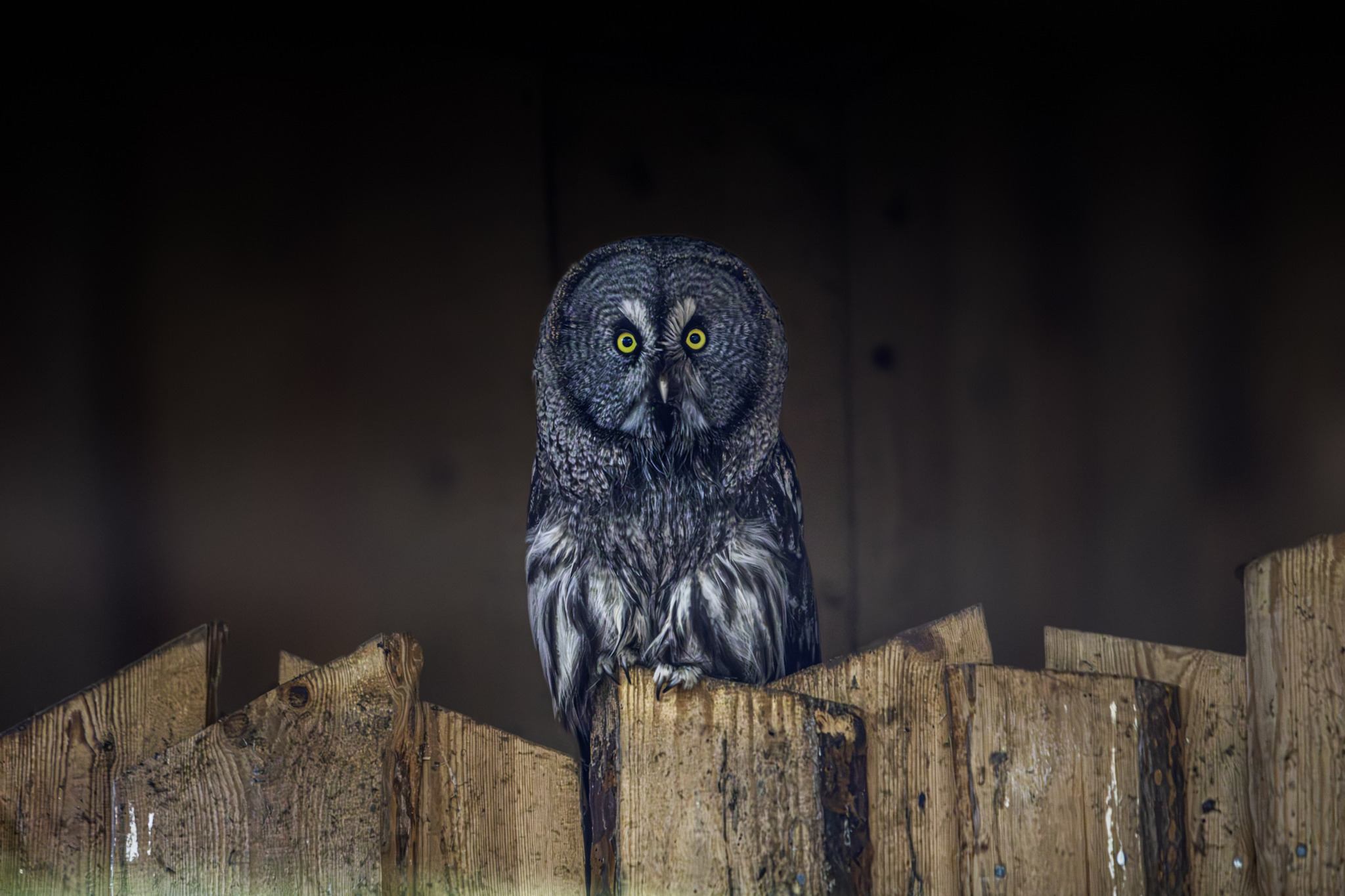The Great Grey Owl (Strix nebulosa), also known as the Great Gray Owl or the Lapland Owl, is a majestic bird known for its impressive size and distinctive appearance. Here are some detailed characteristics and information about the Great Grey Owl:
Appearance
- Size: The Great Grey Owl is one of the largest owls in terms of length, measuring 61 to 84 centimeters. Despite their large size, they are not particularly heavy, weighing between 790 to 1450 grams, because much of their bulk comes from their dense plumage.
- Wingspan: Their wingspan ranges from 140 to 152 centimeters, which aids in their silent flight.
- Coloration: They have a distinctive grey coloration with fine white, grey, and brown streaks and barring. Their facial disc is large and rounded with concentric rings of darker feathers.
- Facial Features: The Great Grey Owl has bright yellow eyes surrounded by darker feathers, giving it a striking, almost stern appearance. They also have a white “bow tie” marking under the beak.
Habitat
- Preferred Habitats: They inhabit dense coniferous forests, taiga, and boreal forests, often near open areas like meadows and wetlands. They prefer areas with abundant prey and suitable nesting sites.
- Geographic Range: The Great Grey Owl is found across the Northern Hemisphere, with populations in North America (primarily in Canada and Alaska, but also in the northern United States), Scandinavia, Russia, and parts of northern Asia.
Behavior
- Nocturnal and Crepuscular: They are primarily nocturnal and crepuscular, meaning they are most active during the night and twilight hours. However, they can also hunt during the day, especially during the breeding season.
- Territorial: Great Grey Owls are territorial and will defend their nesting sites aggressively. They have large home ranges, which can vary depending on prey availability.
- Vocalizations: Their calls include a series of deep, resonant hoots used primarily during the breeding season for territorial and mating purposes.
Diet
- Hunting and Feeding: Their diet mainly consists of small mammals, particularly voles and lemmings. They are also known to hunt birds and other small animals.
- Hunting Techniques: Great Grey Owls use their excellent hearing to locate prey beneath the snow or ground cover. They have asymmetrical ears that allow for precise triangulation of sound, enabling them to catch prey even in complete darkness or under snow.
Reproduction
- Breeding Season: The breeding season typically occurs from late winter to early spring.
- Nesting: They do not build their own nests but instead use old nests built by other large birds, such as hawks or ravens, or natural platforms such as broken tree trunks.
- Eggs and Incubation: Females lay 2 to 5 eggs, which are incubated for about 28 to 36 days. The female incubates the eggs while the male provides food.
- Fledging: The chicks fledge about 3 to 4 weeks after hatching but remain dependent on their parents for several months.
Conservation Status
- Population: The Great Grey Owl is currently listed as Least Concern by the IUCN. However, they are considered vulnerable in certain regions due to habitat loss and changes in prey availability.
- Protection: Conservation efforts focus on preserving their forest habitats and ensuring the availability of prey.
Interesting Facts
- Silent Flight: Their flight is nearly silent due to the unique structure of their wing feathers, which minimizes sound and allows them to hunt without alerting their prey.
- Facial Disc: The large facial disc of the Great Grey Owl functions like a satellite dish, funneling sound to their ears and enhancing their ability to hear prey.
- Longevity: They can live up to 20 years in the wild, although life expectancy can be shorter due to environmental pressures and predation.
Identifying Strix nebulosa
- Distinctive Features: The large size, prominent facial disc with concentric rings, bright yellow eyes, and overall grey coloration make the Great Grey Owl easily recognizable.
- Behavioral Traits: Observing their silent flight, hunting behavior, and unique vocalizations can aid in identification.
In summary, the Great Grey Owl (Strix nebulosa) is a remarkable bird of prey known for its size, striking appearance, and specialized hunting adaptations. Found across the Northern Hemisphere, this owl species plays a crucial role in its ecosystem and is a subject of ongoing conservation efforts to ensure its continued survival.
Views: 27
Subscribe to the newsletter:
